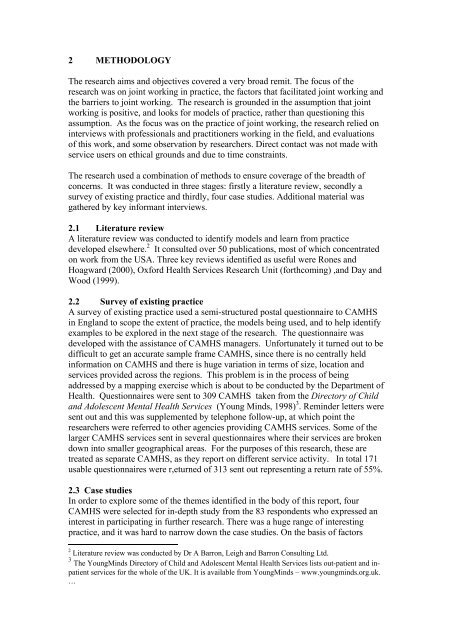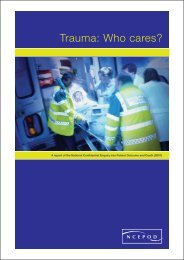(CAMHS) and Schools - London Health Programmes
(CAMHS) and Schools - London Health Programmes
(CAMHS) and Schools - London Health Programmes
You also want an ePaper? Increase the reach of your titles
YUMPU automatically turns print PDFs into web optimized ePapers that Google loves.
2 METHODOLOGY<br />
The research aims <strong>and</strong> objectives covered a very broad remit. The focus of the<br />
research was on joint working in practice, the factors that facilitated joint working <strong>and</strong><br />
the barriers to joint working. The research is grounded in the assumption that joint<br />
working is positive, <strong>and</strong> looks for models of practice, rather than questioning this<br />
assumption. As the focus was on the practice of joint working, the research relied on<br />
interviews with professionals <strong>and</strong> practitioners working in the field, <strong>and</strong> evaluations<br />
of this work, <strong>and</strong> some observation by researchers. Direct contact was not made with<br />
service users on ethical grounds <strong>and</strong> due to time constraints.<br />
The research used a combination of methods to ensure coverage of the breadth of<br />
concerns. It was conducted in three stages: firstly a literature review, secondly a<br />
survey of existing practice <strong>and</strong> thirdly, four case studies. Additional material was<br />
gathered by key informant interviews.<br />
2.1 Literature review<br />
A literature review was conducted to identify models <strong>and</strong> learn from practice<br />
developed elsewhere. 2 It consulted over 50 publications, most of which concentrated<br />
on work from the USA. Three key reviews identified as useful were Rones <strong>and</strong><br />
Hoagward (2000), Oxford <strong>Health</strong> Services Research Unit (forthcoming) ,<strong>and</strong> Day <strong>and</strong><br />
Wood (1999).<br />
2.2 Survey of existing practice<br />
A survey of existing practice used a semi-structured postal questionnaire to <strong>CAMHS</strong><br />
in Engl<strong>and</strong> to scope the extent of practice, the models being used, <strong>and</strong> to help identify<br />
examples to be explored in the next stage of the research. The questionnaire was<br />
developed with the assistance of <strong>CAMHS</strong> managers. Unfortunately it turned out to be<br />
difficult to get an accurate sample frame <strong>CAMHS</strong>, since there is no centrally held<br />
information on <strong>CAMHS</strong> <strong>and</strong> there is huge variation in terms of size, location <strong>and</strong><br />
services provided across the regions. This problem is in the process of being<br />
addressed by a mapping exercise which is about to be conducted by the Department of<br />
<strong>Health</strong>. Questionnaires were sent to 309 <strong>CAMHS</strong> taken from the Directory of Child<br />
<strong>and</strong> Adolescent Mental <strong>Health</strong> Services (Young Minds, 1998) 3 . Reminder letters were<br />
sent out <strong>and</strong> this was supplemented by telephone follow-up, at which point the<br />
researchers were referred to other agencies providing <strong>CAMHS</strong> services. Some of the<br />
larger <strong>CAMHS</strong> services sent in several questionnaires where their services are broken<br />
down into smaller geographical areas. For the purposes of this research, these are<br />
treated as separate <strong>CAMHS</strong>, as they report on different service activity. In total 171<br />
usable questionnaires were r,eturned of 313 sent out representing a return rate of 55%.<br />
2.3 Case studies<br />
In order to explore some of the themes identified in the body of this report, four<br />
<strong>CAMHS</strong> were selected for in-depth study from the 83 respondents who expressed an<br />
interest in participating in further research. There was a huge range of interesting<br />
practice, <strong>and</strong> it was hard to narrow down the case studies. On the basis of factors<br />
2 Literature review was conducted by Dr A Barron, Leigh <strong>and</strong> Barron Consulting Ltd.<br />
3 The YoungMinds Directory of Child <strong>and</strong> Adolescent Mental <strong>Health</strong> Services lists out-patient <strong>and</strong> inpatient<br />
services for the whole of the UK. It is available from YoungMinds – www.youngminds.org.uk.<br />
…

















